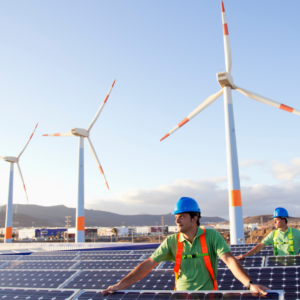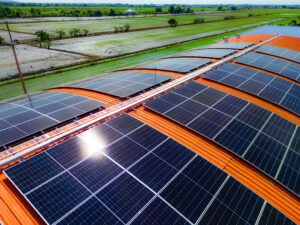With its abundant natural resources, Indonesia is poised to become a leader in the green energy sector with an estimated 400 gigawatts (GW) of potential for renewable-based power generation, with solar energy accounting for half of that figure. Hydropower and geothermal sources could contribute up to 75GW and 29GW capacity, respectively.
Indonesia also holds significant potential as a center for carbon capture and storage (CCS), with an estimated four to eight gigatons of carbon dioxide (CO2) storage potential by leveraging depleted oil and gas reservoirs. Utilizing Indonesia’s saline aquifers could add 600 billion tons of CO2 storage potential. Regarding the production of green molecules, Indonesia is also positioned to become one of the region’s leaders. As an emerging economy with a growing industrial sector, there is an increasing demand for industries such as steel, cement, and chemicals to switch to green hydrogen to accelerate their decarbonization. The demand for green hydrogen across Asia will reach more than 300 million tonnes per annum (mtpa) by 2050.
In this context, the State Electricity Company (PLN) plays a pivotal role in implementing government policies and managing the national grid. However, the company faces challenges in integrating renewable energy sources due to the limitations of the existing infrastructure.
Indonesia holds promising prospects in renewable energy, particularly in carbon capture and storage (CCS), with potential storage of four to eight gigatons of carbon dioxide (CO2) in depleted oil and gas reservoirs. The country is also poised to be a key player in producing green molecules, responding to the growing demand for industries like steel, cement, and chemicals to adopt green hydrogen for decarbonization.
However, this shift towards sustainable practices faces a paradox as Indonesia’s transition from coal to renewable energy is marked by adjustments in government targets and priorities. Despite global ambitions for a zero-emissions future, the government has lowered its renewable energy mix target from 23 percent to a range of 17 to 19 percent for 2025. This new plan is found in the draft revision of the Government Regulation on National Energy Policy, which the National Energy Council is discussing. Even though it is still in design, the intention to reduce the portion of clean energy appears to deviate from the government’s touting of entering a new phase of green business through decarbonization.
Indonesia’s ambition to establish itself as a global player in the electric vehicle supply chain, propelled by outgoing President Joko Widodo’s flagship policy, faces uncertainty. Widodo’s focus on utilizing the country’s abundant nickel reserves, a crucial component in EV batteries, attracted investments from global companies like Hyundai Motor and Foxconn. However, challenges have emerged, including safety concerns after a deadly explosion at a Chinese-controlled nickel facility, delays in mining permits, and environmental issues.
Chinese companies, including Tsingshan and Zhejiang Huayou Cobalt, have established processing plants in Indonesia to secure nickel supplies. While this has boosted foreign direct investment and trade surplus, concerns over dependence on China for funding and technology have arisen. Safety standards and environmental damage have become contentious issues, with a recent exposé shedding light on ecological concerns in the nickel industry.
Indonesia’s ability to reduce dependence on China, improve environmental standards, and address fundamental risks faces obstacles. The European Union is challenging Indonesia’s nickel export ban at the World Trade Organization, potentially impacting the downstream strategy. The global electric vehicle market’s slowdown and a nickel supply glut have led to a price decline. The new Indonesian leader must navigate these challenges and decide on the country’s future direction in the EV supply chain.
At the same time, The Indonesian government is under pressure to assess the public health and socioeconomic consequences of widespread coal use as it implements the Just Energy Transition Partnership (JETP). Environmental groups have urged the government to address the declining quality of life in communities near coal-fired power plants due to emitted pollutants.
The JETP, a $20 billion commitment considered the largest energy financing package globally, includes plans for the early retirement of coal plants. However, critics point out shortcomings in the JETP Comprehensive Investment and Policy Plan (CIPP), including the absence of crucial aspects like human rights, ethical governance, and social, ecological, and economic justice.
To realize its potential as a regional green energy hub, Indonesia needs to fast-track the adoption of renewable energy, implement appropriate policies, develop infrastructure, and enhance capabilities across the supply chain. Several potential policy levers are highlighted to incentivize investment, including commercial tariff premiums or above-market rates for renewable energy fed into the national grid.
Transparency in markets and stable policies are emphasized as essential components. A well-communicated plan for scaling up renewable energy, backed by coherent national energy policies, is vital for investor confidence. Strengthening capabilities, infrastructure, and regional collaboration is crucial for fast-tracking Indonesia’s development as a green energy hub.
Scaling capability development in green technologies, particularly in emerging areas like green hydrogen and carbon capture and storage (CCS), is key. Government funding for R&D, support for research institutions, collaboration with universities, and incentivizing private sector R&D through tax benefits contribute to this effort. Coherent policies across demand, supply, and infrastructure are necessary for accelerating capability development across the green value chain.
Accelerating the development of Indonesia’s carbon market and implementing suitable carbon taxes are emphasized to drive the growth of a green ecosystem and unlock potential funding pools. Regional collaboration, particularly through initiatives like the ASEAN Power Grid, is vital for connecting opportunities across Southeast Asia and facilitating electricity trading agreements and infrastructure deployment.






